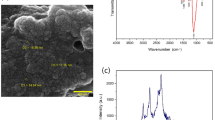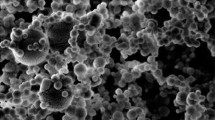Abstract
Piezoelectric materials can generate electrical activity under deformation. Various types of these materials have been used for tissue regeneration, especially in bone repair, in which the charges caused by mechanical stress can increase bone formation. Designing polymeric scaffolds with mechanical and biological properties similar to the extracellular matrix is an important approach in tissue engineering. Therefore, developing nanofiber scaffolds that mimic the extracellular matrix is a positive step toward the formation of new functional tissue. In the present study, we aimed to fabricate a nanofiber scaffold with piezoelectric properties, containing hydroxyapatite particles. Initially, the optimum conditions for electrospinning of the composite fibers were determined from the combination of poly-capro-lactone (PCL), poly-vinylidene fluoride (PVDF) and hydroxyapatite (HA). Then, the effect of mechanical strain on voltage generation was investigated and the piezoelectric property of the scaffolds was calculated. Finally, the behavior of cells (MG63) on the scaffolds was evaluated. The PVDF/PCL/HA scaffold showed an approximate 20% increase in piezoelectric properties compared to a PCL scaffold. Similarly, the three-component scaffold (PVDF/PCL/HA) revealed significant improvement in cell adhesion and function compared to the PCL counterpart and presented almost 12% growth in alkaline phosphatase activity and mineralization. Overall, the results showed that the PVDF/PCL/HA scaffold has the features to induce the proper function of bone cells and satisfy the necessities of bone tissue engineering. To the best of the authors’ knowledge, the simultaneous effect of PVDF and PCL with HA nanoparticles in the form of nanofibers has not yet been investigated and it is considered a novelty in this aspect, in which the presence of poly-capro-lactone as a companion polymer seems to improve the degradation of scaffolds.
Graphical abstract









Similar content being viewed by others
References
Vasita R, Katti DS (2006) Nanofibers and their applications in tissue engineering. Int J Nanomed 1:15–30
Khajavi R, Abbasipour M, Bahador A (2016) Electrospun biodegradable nanofibers scaffolds for bone tissue engineering. J Appl Polym Sci. https://doi.org/10.1002/app.42883
Khorshidi S, Karkhaneh A (2017) Electrically conductive gel/fibers composite scaffold with graded properties. Mater Sci Eng C 74:238–245
Ansari S, Karkhaneh A, Bonakdar S, Haghighipour N (2019) Simultaneous effects of hydrostatic pressure and dexamethasone release from electrospun fibers on inflammation-induced chondrocytes. Eur Polym J 118:244–253
Khorshidi S, Karkhaneh A, Bonakdar S (2020) Oxygen-releasing nanofibers for breathable bone tissue engineering application. J Biomater Appl 35:72–82
Khorshidi S, Karkhaneh A (2018) On-demand release of ciprofloxacin from a smart nanofiber depot with acoustic stimulus. J Biosci 43:959–967
Smith LA, Beck JA, Ma PX (2007) Nanofibrous scaffolds and their biological effects. Nanotechnologies for the life sciences. Wiley, Weinheim, pp 188–215
Khorshidi S, Karkhaneh A (2018) A review on gradient hydrogel/fiber scaffolds for osteochondral regeneration. J Tissue Eng Regen Med 12:1974–1990
Khorshidi S, Karkhaneh A (2016) Formation of three-dimensionality in polyaniline-based nanofibers: a highly conductive permeable scaffold for stem cells residence. Int J Polym Mater Polym Biomater 65:629–635
Imani F, Karimi-Soflou R, Shabani I, Karkhaneh A (2021) PLA electrospun nanofibers modified with polypyrrole-grafted gelatin as bioactive electroconductive scaffold. Polymer (Guildf) 218:123487
Khorshidi S, Karkhaneh A (2018) Particle-coated electrospun scaffold: a semi-conductive drug eluted scaffold with layered fiber/particle arrangement. J Biomed Mater Res Part A 106:3248–3254
Khorshidi S, Karkhaneh A (2018) Hydrogel/fiber conductive scaffold for bone tissue engineering. J Biomed Mater Res Part A 106:718–724
Ribeiro C, Sencadas V, Correia DM, Lanceros-Mendez S (2015) Piezoelectric polymers as biomaterials for tissue engineering applications. Colloid Surf B Biointerf 136:46–55
Khorshidi S, Ansari S, Naghizadeh Z, Akbari N, Karkhaneh A, Haghighipour N (2019) Concurrent effects of piezoelectricity and hydrostatic pressure on chondrogenic differentiation of stem cells. Mater Lett 246:71–75
Kawai H (1969) The piezoelectricity of poly(vinylidene fluoride). Jap J ApplPhys 8:975–976
Harrison JS, Ounaies Z (2001) Piezoelectric Polymers. ICASE NASA Langley Research Center, pp 1–26
Shaunak S, Dhinsa BS, Khan WS (2017) The role of 3D modelling and printing in orthopaedic tissue engineering: a review of the current literature. Curr Stem Cell Res Ther 12:225–232
Ulery BD, Nair LS, Laurencin CT (2011) Biomedical applications of biodegradable polymers. J Polym Sci Part B Polym Phys 49:832–864
Michel J, Penna M, Kochen J, Cheung H (2015) Recent advances in hydroxyapatite scaffolds containing mesenchymal stem cells. Stem Cell Int 2015:1–13
Surmenev RA, Chernozem RV, Pariy IO, Surmeneva MA (2021) A review on piezo- and pyroelectric responses of flexible nano- and micropatterned polymer surfaces for biomedical sensing and energy harvesting applications. Nano Energy 79:105442
Eslami H, Solati-Hashjin M, Tahriri M, Bakhshi F (2010) Synthesis and characterization of nanocrystalline hydroxyapatite obtained by the wet chemical technique. Mater Sci Polym 28:5–13
Farzadi A, Bakhshi F, Solati-Hashjin M, Asadi-Eydivand M, Abu Osman NA (2014) Magnesium incorporated hydroxyapatite: synthesis and structural properties characterization. Ceram Int 40:6021–6029
Montazeri L, Javadpour J, Shokrgozar MA, Bonakdar S, Javadian S (2010) Hydrothermal synthesis and characterization of hydroxyapatite and fluorhydroxyapatitenano-size powders. Biomed Mater 5:045004
Son SR, Linh NTB, Yang HM, Lee BT (2013) In vitro and in vivo evaluation of electrospun PCL/PMMA fibrous scaffolds for bone regeneration. Sci Technol Adv Mater 14:015009
Hassan MI, Sultana N (2017) Characterization, drug loading and antibacterial activity of nanohydroxyapatite/polycaprolactone (nHA/PCL) electrospun membrane. 3 Biotech 7:249
Bayrak E, Ozcan B, Erisken C (2017) Processing of polycaprolactone and hydroxyapatite to fabricate graded electrospun composites for tendon-bone interface regeneration. J Polym Eng 37:99–106
She H, Xiao X, Liu R (2007) Preparation and characterization of polycaprolactone-chitosan composites for tissue engineering applications. J Mater Sci 42:8113–8119
Guo HF, Li ZS, Dong SW, Chen WJ, Deng L, Wang YF, Ying DJ (2012) Piezoelectric PU/PVDF electrospun scaffolds for wound healing applications. Colloid Surf B Biointerf 96:29–36
Damaraju SM, Wu S, Jaffe M, Arinzeh TL (2013) Structural changes in PVDF fibers due to electrospinning and its effect on biological function. Biomed Mater 8:045007
Chandrasekar A, Sagadevan S, Dakshnamoorthy A (2013) Synthesis and characterization of nano-hydroxyapatite (n-HAP) using the wet chemical technique. Int J Phys Sci 8:1639–1645
Nikkhah M, Edalat F, Manoucheri S, Khademhosseini A (2012) Engineering microscale topographies to control the cell-substrate interface. Biomaterials 33:5230–5246
Gittens RA, McLachlan T, Olivares-Navarrete R, Cai Y, Berner S, Tannenbaum R, Schwartz Z, Sandhage KH, Boyan BD (2011) The effects of combined micron-/submicron-scale surface roughness and nanoscale features on cell proliferation and differentiation. Biomaterials 32:3395–3403
Faia-Torres AB, Charnley M, Goren T, Guimond-Lischer S, Rottmar M, Maniura-Weber K, Spencer ND, Reis RL, Textor M, Neves NM (2015) Osteogenic differentiation of human mesenchymal stem cells in the absence of osteogenic supplements: a surface-roughness gradient study. Acta Biomater 28:64–75
Deligianni DD, Katsala ND, Koutsoukos PG, Missirlis YF (2000) Effect of surface roughness of hydroxyapatite on human bone marrow cell adhesion, proliferation, differentiation and detachment strength. Biomaterials 22:87–96
Acknowledgements
The authors would like to thank members of the Functional Fibrous Materials Research Lab at ATMT Research Institute, Textile Engineering Department, Amirkabir University of Technology for their cooperation in measuring the piezoelectric response.
Author information
Authors and Affiliations
Corresponding author
Rights and permissions
About this article
Cite this article
Akbari, N., Khorshidi, S. & Karkhaneh, A. Effect of piezoelectricity of nanocomposite electrospun scaffold on cell behavior in bone tissue engineering. Iran Polym J 31, 919–930 (2022). https://doi.org/10.1007/s13726-022-01047-7
Received:
Accepted:
Published:
Issue Date:
DOI: https://doi.org/10.1007/s13726-022-01047-7




